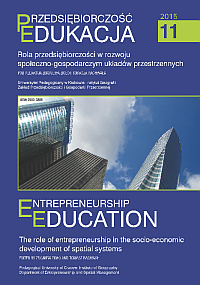Conditioning of entrepreneurs’ and farmers’ activities at outdoor markets, on the example of Nowa Huta
DOI:
https://doi.org/10.24917/20833296.11.15Keywords:
farmer, trader, entrepreneur, entrepreneurship, enterprise, outdoor market, market, micro- enterprise, Nowa HutaAbstract
The beginnings of the Nowa Huta District date back to 1949. Initially founded as an independentcity, Nowa Huta was incorporated into Krakow in 1951 as one of its districts. Outdoor markets in Nowa Huta played an important role in the life of the local community, creating opportunities forshopping as well as for developing neighbourly relations. Nowa Huta residents appreciated their outdoor markets during the time of the centrally controlled economy because of the availability ofsome products and goods not available in local shops. The importance of the markets did not decrease after 1989 either, as they changed during the system and socio-economic transformation (which contributed to the transformation of commercial and service functions). They began attracting a newtype of entrepreneur who offered a new assortment of goods. The condition of markets depends ontheir location. However, it seems that they have not suffered from the competition of neighbouring large-sized super and hypermarkets or, to some extent, these two types of trade have learnt to coexist.The study covered three outdoor marketplaces. These are: Mogilski Plac Targowy, Bienczycki PlacTargowy and “Tomex”, all located within the 25 oldest residential settlements of Nowa Huta District (with a population slightly exceeding 50,000 people) or in their direct neighbourhood. The purpose ofthe research was to identify the assortment of goods offered by the markets, the structure of traders, and their attitude to their business location together with the general conditions of small enterprisesoperating in outdoor markets. A research survey method was used and applied in direct interviews with entrepreneurs operating in the outdoor markets. The research was carried out in May and Juneof 2014.It was identified that the markets included in the analysis developed a specialisation in assortment asa result of the following factors: location of the markets in the urban space (central/peripheral locationfactor and accessibility), 2) the size of the market (development factor and assortment variety factor)and 3) history of operation (the socio-economic factor/context of the initiation of the market operation,consolidation of the dominant structure of the assortment and its permanence in the awareness ofthe local community). The markets are characterised by a dominant share of entrepreneurs runningfamily businesses as compared to private business run by one person or in collaboration with unrelated persons. According to respondents, a common and continuous deterioration of market conditions isobserved both on their markets and in general, chiefly as a result of the competition of hypermarkets and higher demands from the clients resulting from growing customer awareness. The above requires continued customer acquisition and appreciation of one’s existing, stable customer base.
References
Effects and Impact of Entrepreneurship Programmes in Higher Education. (2012). Brussels: European Commission, DG Enterprise and Industry.
Gądecki, J. (2012). I Love Nowa Huta. Gentryfikacja Nowej Huty?. Warszawa: Wydawnictwo IFiS PAN.
Lichtarski, J. (red.). (2007). Podstawy nauki o przedsiębiorstwie. Wrocław: Wydawnictwo AE im. Oskara Langego we Wrocławiu.
Piasecki, B. (red.). (2001). Ekonomika i zarządzanie małą firmą. Warszawa-Łódź.
Piecuch, T. (2010). Przedsiębiorczość, podstawy teoretyczne. Warszawa: Wydawnictwo C.H. Beck.
Płaziak, M. (2014). Przemiany funkcji handlowo-usługowych w mieście postsocjalistycznym na przykładzie Nowej Huty. W: E. Kaczmarska, P. Raźniak (red.), Społeczno-ekonomiczne i przestrzenne przemiany struktur regionalnych. Kraków: Oficyna Wydawnicza AFM, 85-100.
Płaziak, M., Szymańska, A.I. (2014a). Rola placów targowych w strukturze przestrzenno-społecznej i ekonomicznej Nowej Huty. W: E. Kaczmarska, P. Raźniak (red.), Społeczno-ekonomiczne i przestrzenne przemiany struktur regionalnych. 2, Kraków: Oficyna Wydawnicza AFM (w druku).
Płaziak, M., Szymańska, A.I. (2014b). Otwartość na innowacje jako przejaw przedsiębiorczości ludzi młodych na przykładzie studentów uczelni krakowskich. Horyzonty Wychowania, 13(26), 267-286.
Sudoł, S. (2006). Przedsiębiorstwo. Podstawy nauki o przedsiębiorstwie. Zarządzanie przedsiębiorstwem. Warszawa: PWE.
Urbaniec, M. (2014). Współczesne wyzwania edukacji na rzecz przedsiębiorczości w szkolnictwie wyższym. Horyzonty Wychowania, 13(26), 209-230.
Wach, K. (2014). Paradygmat gospodarki przedsiębiorczej a polityka wspierania przedsiębiorczości. W: K. Zieliński (red.), Formy i przejawy współczesnej przedsiębiorczości w Polsce. Warszawa: Difin, 13-30.
Wach, K. (2012). Europeizacja małych i średnich przedsiębiorstw. Rozwój przez umiędzynarodowienie. Warszawa: Wydawnictwo Naukowe PWN.
Wiatrak, A.P. (2003). Pojęcie przedsiębiorczości, jej cele i rodzaje. W: K. Jaremczuk (red.), Uwarunkowania rozwoju przedsiębiorczości – szanse i zagrożenia. Tarnobrzeg. Wydawnictwo PWSZ.
Downloads
Published
How to Cite
Issue
Section
License
Articles are published under the terms of the Creative Commons License (CC BY-ND 4.0; Attribution– NoDerivs).

